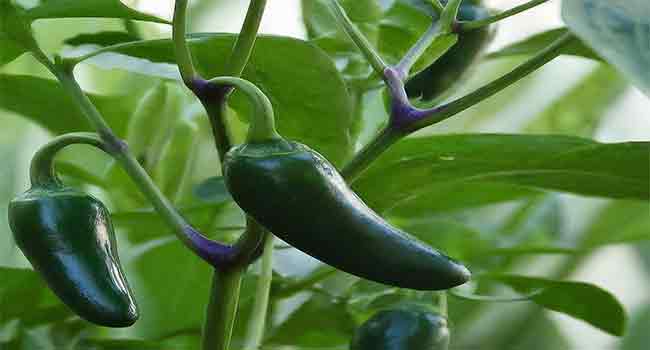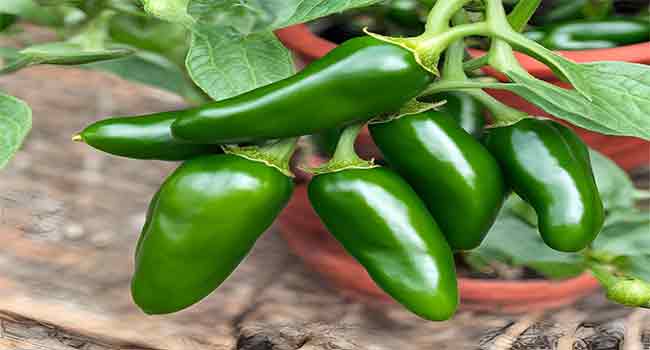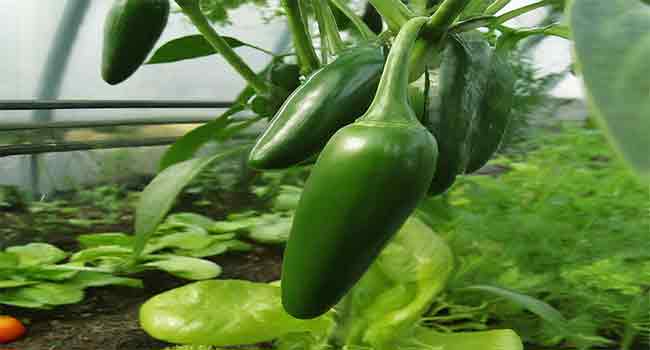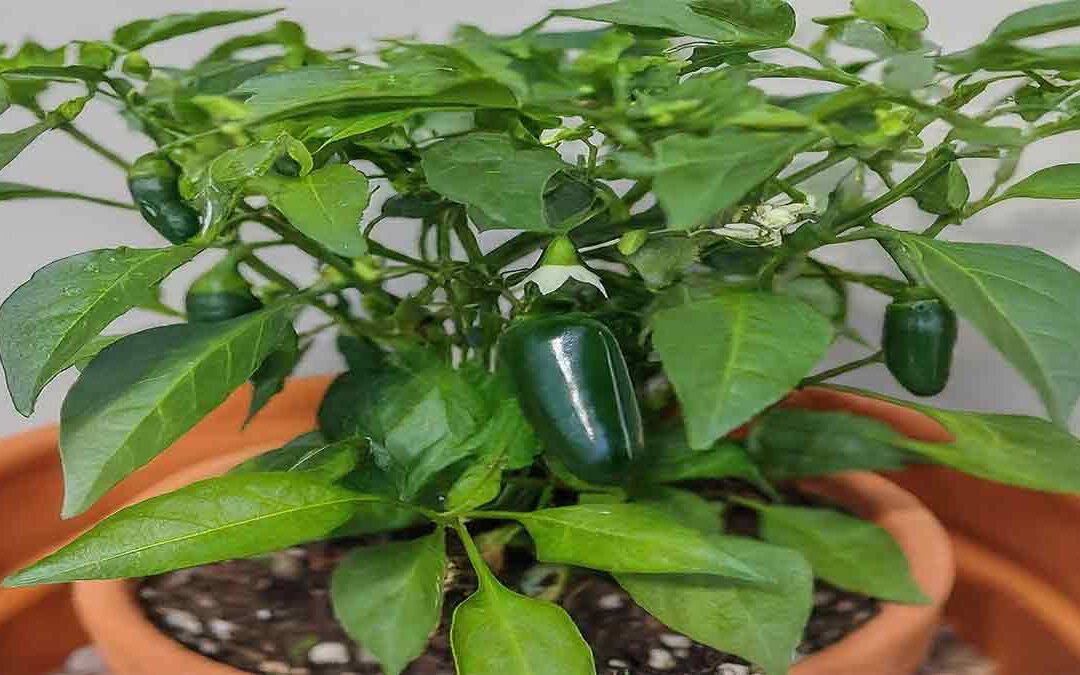Jalapenos, those vibrant green (or red when ripe) peppers, are a culinary powerhouse, celebrated for their unique, piquant flavor. Their versatility in salsas, hot sauces, and countless dishes has made them a favorite for home cooks and professional chefs alike. While traditionally grown outdoors, cultivating jalapenos indoors is gaining popularity. Imagine plucking your own fresh jalapenos straight from a container on your windowsill, no matter the season!
Why Grow Jalapenos Indoors?
- Year-Round Harvest: Extend your growing season and enjoy spicy goodness throughout the year, regardless of the weather outside. Indoor gardening offers the ideal environment for jalapenos to thrive 365 days a year.
- Control Over Conditions: Take charge of your jalapeno harvest by controlling light, temperature, humidity, and even pollination. No more unpredictable weather or pest infestations ruining your pepper plants.
- Limited Space? No Problem: Jalapenos are surprisingly adaptable to container gardening. Whether you have a spacious patio, a sunny balcony, or just a kitchen counter with good light, you can successfully grow jalapenos indoors.
Choosing the Right Jalapeno Variety:
When growing indoors, space is often limited. Opt for compact jalapeno varieties that won’t outgrow their containers. Excellent options for indoor gardens include:
-
- Early Jalapeno: This early-maturing variety remains relatively small, making it perfect for container gardening.
- NuMex Pinata: Known for its small, colorful jalapenos with a mild heat level, NuMex Pinata is an excellent choice for beginners or those who prefer less spicy peppers.
- Tam Mild Jalapeno: If you’re sensitive to heat, Tam Mild Jalapeno offers a milder flavor while still providing that classic jalapeno taste.
Seeds vs. Seedlings: What’s Your Planting Preference?
- Seeds: Starting from seed allows you to choose from a wider variety of jalapenos and offers a rewarding experience as you nurture your plants from germination to harvest. It requires more patience and attention to detail, but the results are worth it.
- Seedlings: If you’re eager for a faster harvest or prefer a more hands-off approach, seedlings are a great option. They’re readily available at nurseries and garden centers, giving you a head start on your jalapeno growing journey.
Heirloom vs. Hybrid Seeds: Which One is Right for You?
- Heirloom Seeds: These open-pollinated seeds have been passed down through generations, offering unique flavors and preserving genetic diversity. They might be less disease-resistant but provide a rich culinary experience.
- Hybrid Seeds: Bred for specific traits like disease resistance, high yield, or uniform fruit size, hybrid seeds offer reliability and predictable results. They might not have the same unique flavor profile as heirloom varieties, but they are often easier to grow.

Where to Find Quality Jalapeno Seeds/Seedlings:
- Reputable Seed Companies: Look for trusted brands specializing in pepper seeds. They offer a vast selection of jalapeno varieties and ensure high-quality seeds for successful germination.
- Local Nurseries: Your local nursery or garden center is likely to have healthy jalapeno seedlings in stock, especially during the spring planting season.
- Online Retailers: For convenience and a wide variety of options, consider purchasing jalapeno seeds or seedlings from reputable online retailers.
Crafting the Perfect Indoor Habitat for Your Jalapenos
Light Up Their World!
Jalapenos are sun-worshippers, and giving them the right amount of light is essential for a successful indoor harvest. Think of it as setting up a mini tanning salon for your peppers – a little excessive, maybe, but they’ll thank you for it with tons of juicy fruits. Here’s the lowdown:
- Why It Matters: Sunlight is like fuel for your jalapenos. Without it, they simply won’t have the energy to flower or produce peppers.
- Grow Light Options: Since we’re growing indoors, we’ll need to recreate the sun’s rays with some trusty grow lights.
- LED Grow Lights: These are like the Teslas of grow lights – sleek, energy-efficient, and packed with the full spectrum of light your peppers need.
- Fluorescent Grow Lights: These are a budget-friendly option that works great for seedlings and younger plants. Think of them as the reliable Toyota Camrys of the grow light world.
- Light Schedule: Jalapenos are kind of like teenagers – they need a solid 12-16 hours of light per day to really hit their growth spurt. Set up a timer so you don’t have to worry about playing light switch all the time.
Temperature & Humidity: Goldilocks Zone
Jalapenos are a bit picky about their climate, so we need to make sure it’s not too hot, not too cold, but just right.
- Ideal Range: Think of it as a comfy spring day – 65-85°F (18-29°C) during the day and a bit cooler at night.
- Humidity: Now, jalapenos like a bit of moisture in the air, but not too much. We’re aiming for that Goldilocks zone of 40-60% humidity.
- Humidity Hacks: If your air is a bit dry, don’t worry! A simple pebble tray filled with water or a humidifier can create the perfect spa-like atmosphere for your peppers.
Containers & Soil: The Perfect Home Base
Just like we need a comfy bed and a solid foundation, our jalapenos need the right containers and soil to grow strong and healthy.
- Containers: Think bigger is better here. Choose pots that are at least 12 inches deep and wide, giving those roots plenty of room to stretch out. And don’t forget drainage holes! No one likes soggy feet, not even pepper plants.
- Soil: This is where your jalapenos get their nutrients, so let’s give them the good stuff! Use a well-draining potting mix specifically made for vegetables. It’s like a gourmet meal for your pepper babies.

Planting & Nurturing Your Pepper Protégés
Alright, plant parents, it’s time to get our hands dirty! Let’s transform those tiny seeds (or cute little seedlings) into thriving jalapeno plants bursting with fiery flavor.
Planting Jalapeno Seeds: From Seed to Sprout
- Seed Starting Mix: To give your seeds the best possible start, use a sterile seed-starting mix. It’s like tucking them into a cozy, disease-free bed where they can safely germinate.
- Planting Depth & Spacing: Don’t bury your seeds too deep! Plant them about ¼ inch deep and give them some personal space – about 2-3 inches apart. Think of it as giving each seed its own little studio apartment to grow.
- Germination Tips: Now for the magic of germination! Keep the soil consistently moist, not soaking, and provide warmth (think 70-80°F or 21-27°C). This is the sweet spot for those seeds to wake up and start sprouting.
Transplanting Jalapeno Seedlings: The Big Move
- When to Transplant: Once your seedlings have grown a bit and have 2-3 sets of “true” leaves (not the tiny ones that first pop up), they’re ready to move to their permanent homes (those pots we prepared earlier!).
- How to Transplant: Be gentle! Carefully remove the seedlings from their starter pots, keeping the root ball intact. Plant them in the new pots at the same depth they were growing before.
- Hardening Off: If you plan to eventually move your jalapenos outdoors, it’s crucial to “harden them off.” This means gradually introducing them to outdoor conditions (sunlight, wind, etc.) over a week or two. It’s like giving them a little boot camp to prepare for the real world!
Watering: The Thirst Quencher
- Consistent Moisture: Jalapenos like their soil to be consistently moist, but not soggy. Think of it like giving them a refreshing drink of water every day, but not drowning them.
- Watering Schedule: A good rule of thumb is to water when the top inch of soil feels dry to the touch. Be mindful of the weather and adjust your watering schedule accordingly – if it’s hot and dry, you might need to water more often.
Fertilizing: The Energy Boost
Think of fertilizer as a power smoothie for your jalapeno plants – a nutrient-rich boost that helps them grow strong and produce those fiery peppers we love.
- Balanced Fertilizer: Your jalapenos are hungry for a balanced diet of nutrients. Look for a fertilizer with equal parts nitrogen (N), phosphorus (P), and potassium (K), often labeled as 10-10-10. This combo will give them the energy they need for healthy growth and abundant fruit production.
- Organic Options: For a more natural approach, consider using organic fertilizers like compost or fish emulsion. These are packed with beneficial microbes and nutrients that will make your jalapenos sing with joy!
- Fertilizing Schedule: Start fertilizing your plants a few weeks after transplanting or when you see the first flowers appear. Feed them every 2-4 weeks throughout the growing season, following the directions on the fertilizer label.
The Importance of Pollination:
In the great outdoors, jalapenos rely on the wind and buzzing bees to spread pollen from one flower to another, ensuring fertilization and fruit production. But indoors, we’ll need to take matters into our own hands.
Hand Pollination: The Art of Matchmaking
- Why It’s Necessary: Indoor environments often lack the natural pollinators that help jalapeno flowers develop into peppers. That’s where we come in!
- How to Do It: Hand pollination is surprisingly easy! All you need is a small brush or cotton swab. Gently dab the pollen from one flower and transfer it to the stigma of another flower. Think of it as playing Cupid for your pepper plants!
- Timing: The best time to hand-pollinate is in the morning when the flowers are fully open and the pollen is fresh.
Signs of Successful Pollination:
- Flower Drop: If pollination is successful, you’ll notice the flowers start to drop off within a few days. Don’t panic! This is a good sign.
- Fruit Development: Soon after, tiny little peppers will start to form. Watch those little guys grow and swell until they reach their full potential!
Pests & Diseases: The Uninvited Guests
- Monitoring: While indoor plants are less prone to pests and diseases, it’s still important to keep a watchful eye. Common culprits include aphids, spider mites, and blossom end rot.
- Treatment: If you notice any signs of trouble, don’t despair! There are many organic pest control methods you can try, like neem oil or insecticidal soap. If you’re unsure, consult with your local nursery for expert advice.
Supporting Your Jalapenos
- Staking: As your jalapeno plants grow taller and heavier with fruit, they might need some extra support. Place a stake near the base of each plant and gently tie the stem to the stake using soft garden twine or strips of cloth. This will prevent the plants from toppling over under the weight of their delicious peppers.
With a little love, patience, and the right know-how, you’ll be harvesting a bounty of homegrown jalapenos in no time. Get ready to spice up your life!

Harvesting Your Spicy Bounty!
Congratulations, plant parent! You’ve nurtured your jalapeno babies from seed (or seedling) to full-grown plants. Now comes the most rewarding part – harvesting those fiery fruits of your labor.
When to Harvest: Is It Go Time?
Deciding when to harvest is a bit like knowing when to pick the perfect avocado – it’s all about timing. Here’s what to look for:
- Color Change: Most jalapenos start green and gradually turn red as they ripen. You can harvest them at either stage, depending on your preference.
- Green Jalapenos: These are crisp and have a bright, zesty flavor. They’re perfect for fresh salsas, pico de gallo, and topping tacos or nachos.
- Red Jalapenos: These are slightly sweeter and have a more complex, smoky flavor. They’re great for roasting, grilling, or making homemade hot sauce.
- Firmness: Give those peppers a gentle squeeze. They should feel firm, not soft or squishy. A firm pepper indicates that it’s reached its peak flavor and texture.
- Taste Test: This is the most fun part! If you’re unsure, go ahead and try a small bite (remembering to wear gloves if you’re sensitive to the heat!). The flavor should be bright and tangy, with the heat level you prefer.
Harvesting Tips: Snip, Snip, Hooray!
- Glove Up: Jalapeno peppers contain capsaicin, the compound that gives them their heat. To protect your hands from the fiery sting, wear gloves when harvesting.
- Sharp Tools: Use sharp scissors or a knife to snip the peppers from the plant. Avoid pulling or twisting, as this can damage the plant and potentially reduce future yields.
Storing Your Spicy Treasures:
You’ve harvested a bounty of jalapenos, now what? Here’s how to keep them fresh and flavorful:
- Refrigerate: Store fresh jalapenos in a plastic bag in the refrigerator crisper drawer. They’ll stay fresh for up to two weeks.
- Dehydrate or Freeze: If you have a surplus of peppers, consider preserving them for later use. Dehydrated jalapenos can be ground into chili powder or used in spice blends, while frozen jalapenos are perfect for adding to soups, stews, or sauces.
Bonus Tip: If you want to encourage your jalapeno plants to produce more peppers, harvest them regularly. The more you pick, the more the plant will produce!
Savor the Flavor:
Now that you have a stash of homegrown jalapenos, it’s time to unleash your culinary creativity! Add them to your favorite salsas, whip up a batch of spicy guacamole, or try your hand at pickling.
And remember, growing jalapenos indoors is an ongoing journey. With the right care and attention, your plants will continue to produce delicious peppers for months to come.

Additional Tips for Successful Indoor Jalapeno Growing:
- Pruning: Regularly prune your jalapeno plants to encourage bushier growth and increase fruit production. Pinch off the tips of young plants to promote branching, and remove any dead or yellowing leaves.
- Support: As your plants grow taller and heavier with fruit, they might need some extra support. Use stakes or cages to keep them upright and prevent them from toppling over.
- Rotate Your Plants: If you’re growing multiple jalapeno plants, rotate their positions regularly to ensure they all receive equal amounts of light.
- Pest and Disease Control: Keep a close eye on your plants for any signs of pests or diseases. Early detection and treatment are key to preventing major issues.
FAQ: Your Questions About Growing Jalapenos Indoors Answered
- Can you grow jalapenos indoors year-round?
Absolutely! That’s one of the biggest perks of indoor gardening. By controlling the environment (light, temperature, etc.), you can enjoy a continuous supply of fresh jalapenos no matter the season.
- What’s the best location in my house for growing jalapenos?
Jalapenos thrive in bright, sunny locations. A south-facing window or a spot under grow lights is ideal. Ensure the temperature stays within the recommended range of 65-85°F (18-29°C) during the day.
- How long does it take to grow jalapenos indoors from seed?
It typically takes about 70-80 days from seed to harvest, but this can vary depending on the variety and growing conditions.
- Do jalapenos need a lot of light to grow indoors?
Yes, they do! Jalapenos are sun-loving plants and require at least 6 hours of direct sunlight or 12-16 hours of light under grow lights to thrive.
- How do you pollinate jalapenos indoors?
Since natural pollinators like bees and wind are scarce indoors, you’ll need to hand-pollinate your jalapenos. Gently transfer pollen from one flower to another using a small brush or cotton swab.
- Why are my jalapeno flowers falling off before producing fruit?
Several factors can cause flower drop, including:
- Insufficient light: Ensure your plants receive enough light.
- Temperature fluctuations: Maintain a consistent temperature range.
- Lack of pollination: Hand-pollinate your flowers.
- Overwatering or underwatering: Keep the soil consistently moist but not waterlogged.
- What are the best jalapeno varieties for growing indoors?
Compact varieties are ideal for indoor growing. Some popular choices include Early Jalapeno, NuMex Pinata, and Tam Mild Jalapeno.
- What kind of soil should I use for my indoor jalapenos?
Use a well-draining potting mix specifically formulated for vegetables. This type of soil provides the right balance of nutrients and drainage to support healthy growth.
- How often should I water my indoor jalapenos?
Water your jalapenos when the top inch of soil feels dry to the touch. Avoid overwatering, as this can lead to root rot.
- How do I protect my indoor jalapenos from pests and diseases?
Inspect your plants regularly for signs of pests or diseases. If you notice any issues, treat them promptly with organic pest control methods or consult your local nursery for advice.
- Can I move my indoor jalapenos outdoors during the summer?
Yes, you can! Gradually acclimate them to outdoor conditions over a week or two before moving them permanently.
- Can I save seeds from my indoor jalapenos and plant them next season?
Yes, you can save seeds from open-pollinated (heirloom) jalapeno varieties. However, seeds from hybrid varieties might not produce plants identical to the parent.
Conclusion:
Growing jalapenos indoors is a rewarding and delicious endeavor. By following this comprehensive guide, you’ll be well on your way to enjoying a year-round supply of fresh, spicy peppers. So, get ready to embrace your inner green thumb and add some heat to your homegrown harvest!

